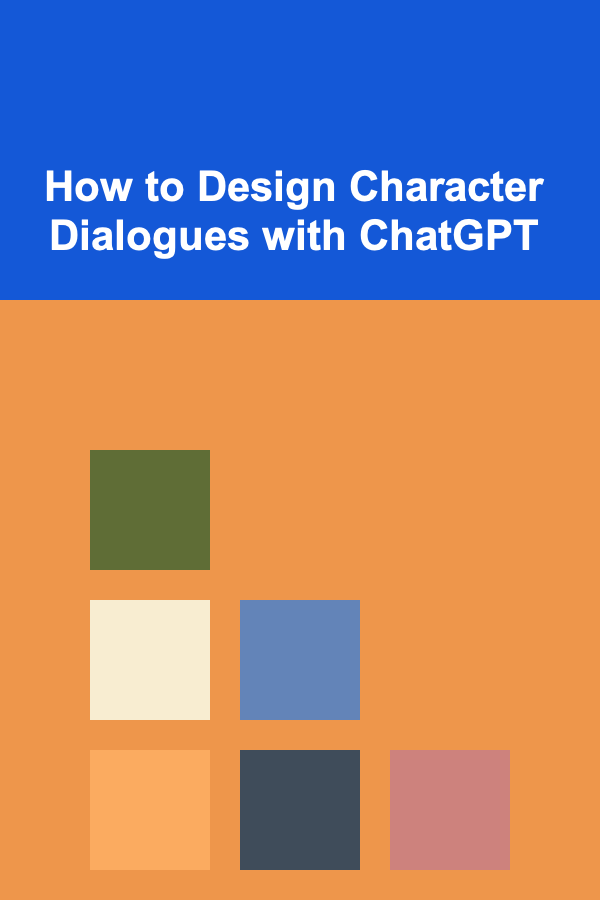
How to Design Character Dialogues with ChatGPT
ebook include PDF & Audio bundle (Micro Guide)
$12.99$5.99
Limited Time Offer! Order within the next:

Designing character dialogues is an essential skill for writers, game developers, screenwriters, and anyone involved in storytelling. In the realm of AI, tools like ChatGPT have revolutionized the process of creating dynamic, realistic dialogues for characters. However, while ChatGPT is a powerful tool, it's important to understand how to use it effectively for creating dialogues that are engaging, authentic, and fit within the narrative. This article delves deep into the process of designing character dialogues with ChatGPT, exploring strategies, techniques, and best practices.
Understanding Character Dialogue
Before diving into how ChatGPT can assist with character dialogues, it's important to first understand what makes good character dialogue. Dialogue is not just a tool for characters to communicate; it's a window into their personalities, motivations, and relationships. Well-crafted dialogue reveals more than just words---it conveys emotions, intentions, and nuances that drive the narrative forward.
Key Aspects of Character Dialogue
- Voice: Each character should have a distinct voice. This means their speech patterns, vocabulary, tone, and pacing should reflect who they are---whether it's a wise old sage, a fiery teenager, or a mysterious villain. Consistency in voice is crucial for maintaining immersion.
- Subtext: Great dialogue often includes what is not said outright. Subtext refers to the underlying meaning behind a character's words, adding complexity and depth to the conversation. A character might say one thing but mean another, or their words could be influenced by their fears, desires, or hidden agendas.
- Conflict: Dialogue is a great tool for driving conflict. Whether it's a subtle disagreement, a heated argument, or an unspoken rivalry, dialogue often showcases the friction between characters, advancing the plot and adding emotional weight.
- Pacing: The rhythm of dialogue is important. Sometimes a quick exchange of words can heighten tension, while a slow, thoughtful conversation can build suspense or reveal deep emotional layers. Understanding how pacing affects tone and emotion is key.
- Context: The environment, situation, and relationship between characters influence their dialogues. A character's tone and choice of words may drastically change depending on whether they're alone, in a tense situation, or speaking to a close friend.
Leveraging ChatGPT for Dialogue Creation
1. Crafting a Character's Voice
When designing a character's voice, you can use ChatGPT to generate lines that reflect their personality and background. Here's how you can approach it:
-
Define the Character's Traits: Before using ChatGPT, write down key traits of your character. Are they optimistic or pessimistic? Are they highly educated or street-smart? Do they speak formally or informally? Once you've established these traits, prompt ChatGPT to generate dialogue that aligns with them.
For example, for a character with a formal, eloquent voice, you could use a prompt like:
For a more relaxed character, you might try:
-
Consistency in Dialogue: ChatGPT can produce dialogue in various tones and styles. However, it's important to maintain consistency throughout a conversation. If a character is formal at the start, they should remain formal unless there's a significant change in the situation that justifies a shift in tone. You can guide ChatGPT to produce consistently on-brand dialogue by using more specific instructions or adjusting previous dialogue for reference.
2. Incorporating Subtext
Subtext adds layers to dialogue, providing deeper meaning without directly stating it. ChatGPT is excellent at generating lines that carry implicit meaning, but you may need to guide it.
-
Direct Requests for Subtext: Instead of simply asking ChatGPT to generate dialogue, you can include a request for subtext. For example:
-
Nuanced Phrasing: If you want ChatGPT to capture more subtle or complex subtext, prompt it to create indirect statements. For example:
By guiding ChatGPT in this way, you can ensure that the dialogue not only sounds realistic but also conveys emotions and tensions that are not explicitly stated.
3. Creating Tension and Conflict
Conflict is at the heart of many stories, and dialogue is often the medium through which it's expressed. Whether the conflict is internal (a character grappling with their own emotions) or external (a confrontation between characters), ChatGPT can assist in crafting powerful moments of conflict.
-
Direct Confrontation: If you want two characters to confront each other, a good prompt might be:
-
Internal Conflict: For internal conflict, where a character struggles with their emotions or choices, you could use:
ChatGPT can help you flesh out these moments, ensuring that the dialogue remains emotionally charged and impactful.
4. Pacing and Rhythm of Dialogue
Pacing can dramatically affect the tone of a scene, and ChatGPT can be used to craft dialogue that matches the desired rhythm.
-
Rapid-Fire Exchanges: For tense situations or heated arguments, fast-paced dialogue can heighten the stakes. A prompt like:
-
Slow, Thoughtful Dialogue: Conversely, for more reflective moments, a slower pace might be appropriate. Try a prompt such as:
By adjusting the pacing of the dialogue, you can create a scene that either builds tension or allows for deeper emotional exploration.
5. Refining Dialogue with Rewrites
Once you've generated your initial dialogue, it's important to refine it. ChatGPT can help with this process by offering multiple variations of a conversation, helping you choose the version that best fits the character or the tone of the scene.
-
Rewriting for Different Tones: If you're unsure whether a character's dialogue is coming across the way you want, you can ask ChatGPT to generate alternative versions with different tones. For example:
-
Exploring Multiple Responses: If you're not sure how a character might react in a given scenario, prompt ChatGPT to provide different potential responses, which you can then select from:
This method allows you to explore a range of possibilities for your character, helping you fine-tune the dialogue until it feels right.
Best Practices for Using ChatGPT to Design Character Dialogues
-
Start with Clear Character Profiles: The more detailed your character profile is, the better ChatGPT will be at creating authentic dialogue. Include information about the character's background, values, and speech habits.
-
Provide Context: Context is critical when crafting dialogue. Include information about the situation in your prompts. Is the character upset, happy, or confused? What's the setting? Are they speaking to a friend, a stranger, or an enemy? The more context you provide, the more accurate and nuanced the dialogue will be.
-
Iterate and Refine: Dialogue often requires several rounds of iteration. Use ChatGPT to generate a first draft, then refine it based on your feedback. Consider experimenting with different prompts to see how small changes affect the dialogue.
-
Use ChatGPT for Inspiration: If you're stuck or unsure how a scene should unfold, you can ask ChatGPT for creative suggestions or brainstorming. For example:
-
Mix AI with Your Own Creativity: While ChatGPT is a powerful tool, it works best when paired with your own creativity. Use AI to help you brainstorm ideas, refine your dialogue, or break through writer's block, but don't rely solely on it. Combine its suggestions with your own writing instincts for the best results.
Conclusion
Designing character dialogues with ChatGPT can be an incredibly effective and efficient process when done correctly. By understanding how to craft a distinct voice, incorporate subtext, create conflict, control pacing, and refine dialogue, you can leverage this AI tool to enhance your storytelling. The key is to use ChatGPT as a tool for exploration, inspiration, and refinement, while always keeping the human touch that gives character dialogue its depth and authenticity. Whether you're writing a novel, developing a video game, or working on a screenplay, mastering character dialogue is crucial to creating compelling, memorable characters---and with ChatGPT, that process has never been easier.

How to Create a Clear Test Report After Product Testing: An Actionable Guide
Read More
How to Deal with Pet Fleas and Ticks in Your Home
Read More
How to Design Eye-Catching Digital Ads for Maximum Engagement
Read More
How to Plan for Major Life Events: Weddings, Home Buying, and More
Read More
How to Properly Care for Your Vacuum Cleaner
Read More
How To Improve Your Aim in Competitive Shooters
Read MoreOther Products

How to Create a Clear Test Report After Product Testing: An Actionable Guide
Read More
How to Deal with Pet Fleas and Ticks in Your Home
Read More
How to Design Eye-Catching Digital Ads for Maximum Engagement
Read More
How to Plan for Major Life Events: Weddings, Home Buying, and More
Read More
How to Properly Care for Your Vacuum Cleaner
Read More